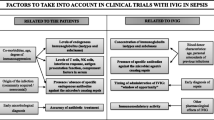Abstract
Background
Guidelines vary regarding the safety of administering intravenous immunoglobulin (IVIG) during infections, although evidence for this advice is lacking and is based on expert opinion.
Aims
We retrospectively studied patients with common variable immunodeficiency who reacted during IVIG therapy as to whether routinely obtained markers of infection such as C-reactive protein (CRP) were elevated.
Methods
19 patients on replacement IVIG therapy in a hospital-based infusion unit were studied. CRP levels obtained were normalized to baseline levels without reactions (defined as 100).
Results
8 of 19 patients had 16 reactions over a total of 107 infusions. Normalized CRP levels during reactions were higher [mean (±SD) of 258 (±215)] than during infusions with no reaction [mean 100 (±54.9), p = 0.017], and higher than in patients who did not react [mean 100 (±79.7), p = 0.017].
Conclusions
Some patients with IVIG reactions had elevated CRP levels suggesting that concurrent infection may have caused the reaction. Pre-emptive antibiotic therapy and delaying infusion could prevent unnecessary morbidity.


Similar content being viewed by others
References
El-Shanawany T, Sewell WA, Misbah SA, Jolles S (2006) Current clinical uses of intravenous immunoglobulin. Clin Med 6(4):356–359
Bonilla FA (2008) Intravenous immunoglobulin: adverse reactions and management. J Allergy Clin Immunol 122(6):1238–1239
UK-Primary Immunodeficiency Network (UKPIN) guideline 2.01. Administration of IVIG. http://www.ukpin.org.uk/guidelines5-01.html. Accessed 5 May 2009
Brennan VM, Salomé-Bentley NJ, Chapel HM (2003) Prospective audit of adverse reactions occurring in 459 primary antibody-deficient patients receiving intravenous immunoglobulin. Clin Exp Immunol 133(2):247–251
Conley ME, Notarangelo LD, Etzioni A (1999) Diagnostic criteria for primary immunodeficiencies. Representing PAGID (Pan-American Group for Immunodeficiency) and ESID (European Society for Immunodeficiencies). Clin Immunol 93(3):190–197
Orange JS, Hossny EM, Weiler CR et al (2006) Primary Immunodeficiency Committee of the American Academy of Allergy, Asthma, Immunology. Use of intravenous immunoglobulin in human disease: a review of evidence by members of the Primary Immunodeficiency Committee of the American Academy of Allergy, Asthma, Immunology. J Allergy Clin Immunol 117(4 Suppl):S525–S553
Day NK, Good RA, Wahn V (1984) Adverse reactions in selected patients following intravenous infusions of gamma globulin. Am J Med 76(3A):25–32
Wahn V (1984) Intravenous gamma globulin therapy. Measurement of circulating immune complexes and complement factors. Fortschr Med 102(31–32):795–798
Lingard H, Zehetmayer S, Maier M (2008) Bacterial superinfection in upper respiratory tract infections estimated by increases in CRP values: a diagnostic follow-up in primary care. Scand J Prim Health Care 26(4):211–215
Melbye H, Hvidsten D, Holm A, Nordbø SA, Brox J (2004) The course of C-reactive protein response in untreated upper respiratory tract infection. Br J Gen Pract 54(506):653–658
Pettit SJ, Bourne H, Spickett GP (2002) Survey of infection in patients receiving antibody replacement treatment for immune deficiency. J Clin Pathol 55(8):577–580
Rhodes B, Merriman ME, Harrison A et al (2010) A genetic association study of serum acute-phase C-reactive protein levels in rheumatoid arthritis: implications for clinical interpretation. PLoS Med 7(9):e1000341
Provan D, Chapel HM, Sewell WAC, O’Shaughnessy D (2008) Prescribing intravenous immunoglobulin: summary of Department of Health Guidelines. BMJ 337:990–992
Acknowledgments
We thank the nursing staff at Scunthorpe General Hospital and Hull Royal Infirmary for help with the data collection. WACS is Director of the Centre for Immunoglobulin Therapy, who has received unrestricted educational grants from Octapharma, Baxter, Grifols, CSL-Behring. There was no specific funding for this study.
Author information
Authors and Affiliations
Corresponding author
Rights and permissions
About this article
Cite this article
Khan, S., Abuzakouk, M., Doré, P.C. et al. Administering intravenous immunoglobulin during infection is associated with infusion reactions in selected patients. Ir J Med Sci 180, 125–128 (2011). https://doi.org/10.1007/s11845-010-0654-4
Received:
Accepted:
Published:
Issue Date:
DOI: https://doi.org/10.1007/s11845-010-0654-4



